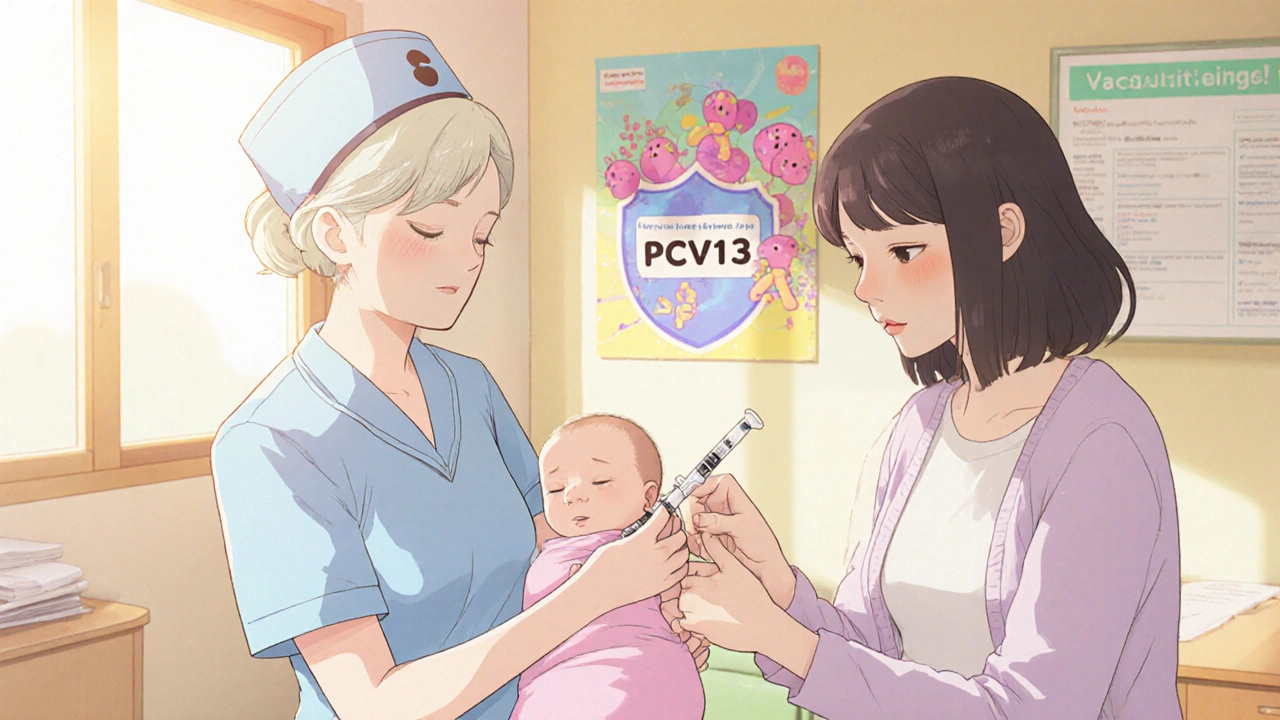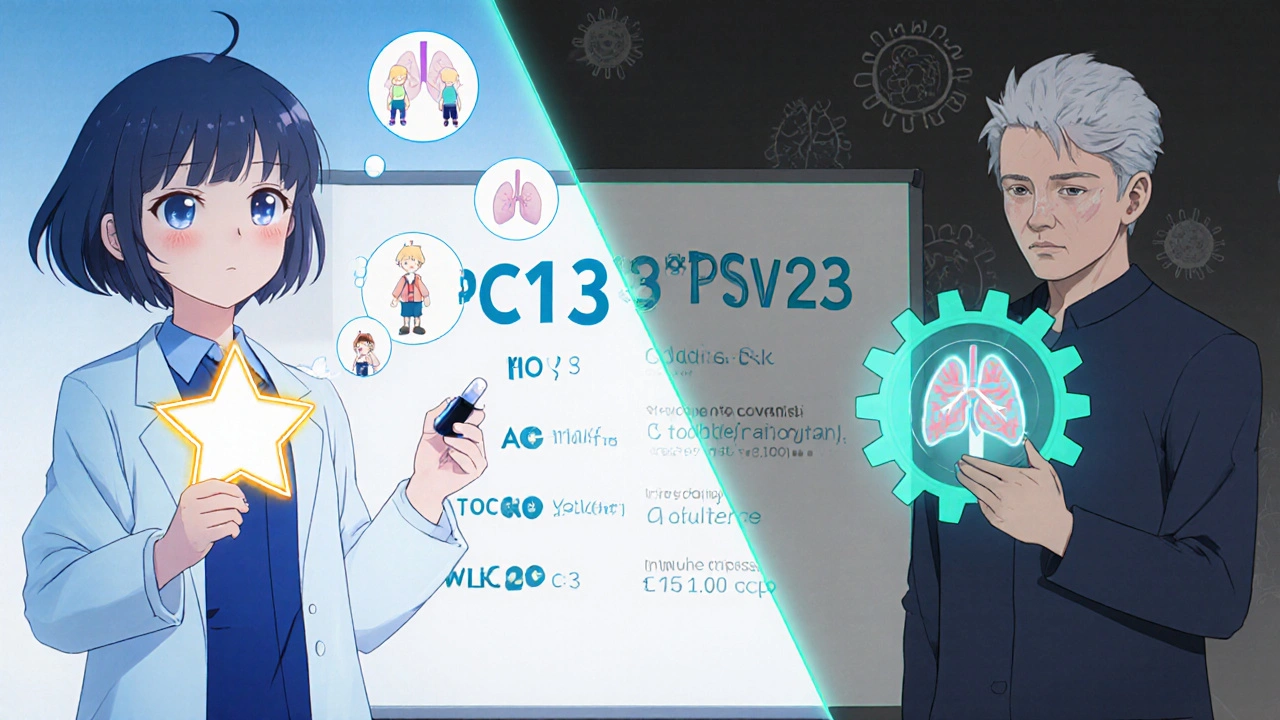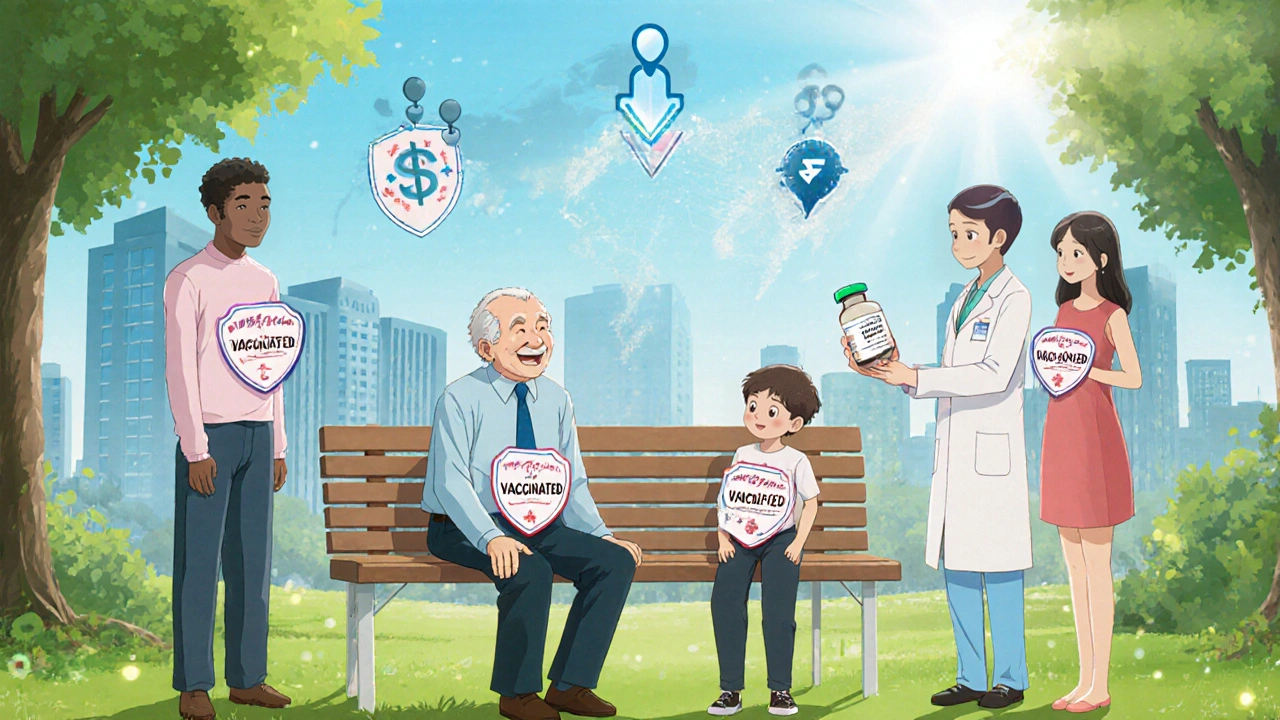Why Pneumonia Vaccines Matter for Kids and Adults
 Oct, 19 2025
Oct, 19 2025
Vaccine Eligibility Calculator
Vaccine Eligibility Calculator
Enter your age and health status to determine which pneumonia vaccine is recommended for you.
Your Vaccination Recommendation
When a simple cough turns into something more serious, the fear of pneumonia can hit fast. The good news? A shot can keep that worry at bay. pneumonia vaccine isn’t a luxury; it’s a frontline defense for children, seniors, and anyone whose immune system needs a boost.
Quick Takeaways
- Pneumonia is caused mainly by Streptococcus pneumoniae, a bacteria that spreads through droplets.
- Two vaccines-PCV13 and PPSV23-cover most disease‑causing strains.
- Kids get a series of doses starting at 2 months; adults 65+ and high‑risk groups need one or two shots later in life.
- Vaccination cuts hospital stays by up to 80 % and curbs community spread.
- Side effects are mild-soreness, low‑grade fever-far less risky than the illness itself.
What is Pneumonia and Why a Vaccine Helps
People often think of pneumonia as "the flu that won’t go away," but it’s a lung infection that inflames the air sacs, filling them with fluid. The most common culprit worldwide is Streptococcus pneumoniae. When the bacteria invade, they can cause fever, chills, rapid breathing, and even death, especially in kids under five and adults over 65.
Vaccines work by teaching the immune system to recognize the bacterial capsular sugars without causing disease. Once trained, the body can neutralize the bug before it settles in the lungs. This pre‑emptive strike not only protects the individual but also reduces the bacteria’s presence in the community-a phenomenon known as herd immunity.
Types of Pneumonia Vaccines
There are two main formulations approved in most countries:
| Feature | PCV13 (13‑valent) | PPSV23 (23‑valent) |
|---|---|---|
| Covered serotypes | 13 most common strains | 23 strains, including all PCV13 serotypes |
| Age group | Infants 2 mo-5 yr; also adults with certain conditions | Adults 65+; immunocompromised teens and adults |
| Immune response | Conjugate - creates strong memory B‑cell response | Polysaccharide - good for short‑term protection |
| Booster needed? | Usually no booster after series, but a PPSV23 booster at 65 yr for adults | One dose for most adults; second dose 5 yr later if high risk |
| Common side effects | Redness, swelling, mild fever | Soreness, low‑grade fever, fatigue |
Both vaccines are safe, but the conjugate nature of PCV13 makes it especially effective in young children, whose immune systems need that extra molecular “hand‑shake.”
Vaccination Schedule for Children
In most national immunization programs-guided by the World Health Organization and the CDC-the schedule looks like this:
- First dose at 2 months of age.
- Second dose at 4 months.
- Third dose at 6 months.
- Booster dose at 12‑15 months (often combined with other routine vaccines).
If a child missed a dose, the series can be caught up by administering the missed shots at least four weeks apart. The key is to complete the series before the child’s first birthday, when the risk of severe bacterial pneumonia spikes.

Vaccination Recommendations for Adults
Adults aren’t exempt. Here’s a practical rundown:
- Age 65 and older: Get a single dose of PCV13 (if not received as a child) followed by PPSV23 at least one year later.
- Immunocompromised or chronic illnesses (e.g., diabetes, heart disease): Receive PCV13 first, then PPSV23 after eight weeks; a second PPSV23 booster after five years.
- Smokers and people with asthma: PPSV23 alone is sufficient, but PCV13 can be added if other risk factors exist.
These guidelines stem from extensive studies showing up to 85 % reduction in invasive pneumococcal disease among vaccinated seniors.
How Vaccines Reduce Hospital Burden
Think of a crowded emergency department during flu season. Add pneumonia and you have a perfect storm. Data from the CDC’s 2023‑24 surveillance report indicate that vaccinated adults over 65 spent 1.2 million fewer days in the hospital compared to unvaccinated peers. For kids, the numbers are even sharper: early‑childhood vaccination cuts pediatric admissions for bacterial pneumonia by roughly 70 %.
Beyond saved beds, the economic impact is huge. Each prevented case saves an average of $13,000 in treatment costs in the U.S., and similar savings are being reported in South Africa’s public health system after integrating PCV13 into the national schedule in 2021.
Safety Profile and Common Concerns
It’s natural to wonder about side effects. The most common reactions are mild and resolve within a couple of days:
- Redness or swelling at the injection site.
- Low‑grade fever (under 38.5 °C).
- Occasional fussiness in toddlers.
Serious allergic reactions are extremely rare-about 1 in a million doses. Health professionals screen for severe egg allergy (relevant for some influenza vaccines, not pneumonia shots) and recent severe illness before administering the shot.
Myths like “the vaccine causes pneumonia” fall flat under scrutiny. The vaccine contains inactivated bacterial components; it cannot cause the disease it protects against.

Access, Affordability, and Global Perspective
In high‑income countries, the vaccine is often covered by national health insurance or private plans. In low‑ and middle‑income regions, initiatives from Gavi, the Vaccine Alliance, and the WHO have subsidized PCV13 for children, dramatically lowering mortality rates in sub‑Saharan Africa.
In South Africa, the public health system offers PCV13 free of charge at government clinics. Adults can receive PPSV23 at a modest co‑pay, and many employers include it in occupational health packages for at‑risk staff.
If you’re traveling abroad-especially to areas with higher pneumonia prevalence-bring proof of vaccination. Some travel health guidelines recommend a booster for travelers over 65 or those with chronic lung disease.
Practical Tips for Getting Vaccinated
- Check your child’s immunization card before school enrollment; most schools require a recent dose.
- Ask your GP or local clinic about the combined PCV13‑PPSV23 schedule if you’re 65+.
- Keep a copy of the vaccination card in your health folder-many apps now let you store it digitally.
- If you experience mild fever after the shot, a cool compress and ibuprofen (for adults) can ease discomfort.
- Schedule the next dose before leaving the clinic; most practices will set a reminder.
Frequently Asked Questions
Can the pneumonia vaccine be given with other childhood shots?
Yes. PCV13 is usually combined with DTaP, Hib, and IPV in a single injection called the “pentacel” in many countries. This reduces the number of clinic visits.
Do I need a pneumonia vaccine if I’ve already had pneumonia?
Having had pneumonia once doesn’t guarantee immunity. The vaccine protects against many strains you may not have encountered, so getting vaccinated is still recommended.
What’s the difference between PCV13 and PPSV23 for seniors?
PCV13 creates a strong, long‑lasting memory response, while PPSV23 covers more strains but offers shorter‑term protection. Giving PCV13 first, followed by PPSV23, gives the best of both worlds.
Are there any contraindications?
Severe allergic reaction to a previous dose or to any component of the vaccine is a contraindication. Mild illness (cold, low‑grade fever) does not preclude vaccination.
How long does protection last?
For children who complete the PCV13 series, protection can last for at least 10 years, often longer. For adults, PPSV23 protection wanes after about 5 years, which is why a booster is advised for high‑risk groups.
Bottom line: Whether you’re a parent, a senior, or a traveler, the pneumonia vaccine is a simple, cost‑effective shield against a disease that still claims thousands of lives every year. Stay informed, stay vaccinated, and help keep the community safe.

Bobby Marie
October 19, 2025 AT 20:00Kids need that early shield because their immune system is still learning. The PCV13 series is a simple routine that saves a lot of trips to the ER later. Adults over 65 should grab the PPSV23 too, it's just a quick jab.
Jameson The Owl
November 2, 2025 AT 17:20The government pushes the pneumonia shots under the guise of public health but the real agenda is control. They claim the PCV13 saves lives while they line up contracts with big pharma. Every dose is a data point collected on our blood and habits. The CDC statistics are inflated to justify more funding for the war machine. They tell us the vaccine is safe yet hidden side effects are buried in obscure journals. A healthy immune system does not need a manufactured antigen to fight a bacterial infection. The pandemic taught us that the elite will use any crisis to experiment on the masses. Immunizations are a Trojan horse for tracking devices hidden in the vial. Trusting a program that was designed in secret labs is a betrayal of our sovereignty. I refuse to be a pawn in this pharmaceutical game.
Sunil Yathakula
November 16, 2025 AT 14:40I totally get why parents worry about another injection. The PCV13 schedule is actually quite easy once you have the immunisation card. It protectes our little ones from a disease that can knock them out for weeks. If you miss a dose just catch up, the doctors are there to help. Stay strong, we all got each other's backs!
sravya rudraraju
November 30, 2025 AT 12:00From a public‑health perspective the introduction of conjugate vaccines represents a paradigm shift. By linking the polysaccharide antigens to a protein carrier, PCV13 elicits a robust T‑cell dependent response, which is especially valuable in infants whose immune repertoire is still immature. The schedule of doses at two, four, six months followed by a booster ensures serotype coverage during the period of greatest vulnerability. Moreover, the herd‑immunity effect observed in communities with high uptake has led to measurable declines in invasive pneumococcal disease among unvaccinated adults. It is also noteworthy that the safety profile remains favourable; most adverse events are limited to mild local reactions and transient low‑grade fever. Health economists have quantified the cost‑effectiveness of the program, citing reductions in hospital admissions and antibiotic usage. In low‑ and middle‑income settings, Gavi’s support has facilitated the incorporation of PCV13 into national immunisation calendars, thereby narrowing the mortality gap. Continued surveillance is essential to monitor serotype replacement phenomena, yet the current evidence underscores the vaccine’s net benefit. In summary, the strategic implementation of PCV13 in early childhood is a cornerstone of modern infectious‑disease control.